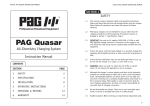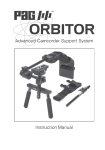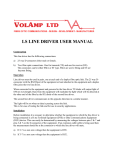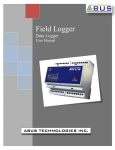Download VOLAMP User Manual
Transcript
Document No. : UserManual_CII_Lite VOLAMP User Manual Page 1 of 21 Document No. : UserManual_CII_Lite Important Powering up the Camlinx II The CamlinxII system takes up to 60 seconds to power up. During this time, video and audio passed by the system is unreliable and should be ignored. Disclaimer All information contained in this manual is believed to be accurate and reliable. However, Volamp Ltd assumes no responsibility for its use. Since conditions of product use are outside our control, we make no warranties express or implied in relation thereto. We therefore cannot accept any liability in connection with any use of this information. This product is not intended for use in life support appliances, devices or systems where a malfunction of the product can reasonably be expected to result in personal injury. Use of any Volamp product in such applications is expressly prohibited. Whilst every effort has been made to ensure that this document is correct, errors can occur. If you find any errors or omissions please let us know, so that we can put them right Laser Safety Invisible laser radiation. Class 1 lasers are used in this product for fibre optic communications. The wavelength used is in the infra-red band so the light emitted cannot be seen. Although the levels are low and are classified as safe under all conditions of normal use, we recommend that users avoid looking directly into the beam. Trademarks Camlinx II is a trade mark of Volamp Limited. Opticalcon ® is a registered mark of Neutrik AG Document updated : 10th October 2014 Page 2 of 21 Document No. : UserManual_CII_Lite Table of Contents Important..........................................................................................................2 Powering up the Camlinx II...............................................................................2 Disclaimer .....................................................................................................2 Laser Safety...................................................................................................2 Trademarks....................................................................................................2 1.Introduction...................................................................................................4 1.1.Block Diagram..........................................................................................5 2.Enclosure.......................................................................................................6 2.1. Head and Base Units................................................................................6 2.2.Dimensions and Weights............................................................................6 3.Configurations................................................................................................7 4.Quick start guide............................................................................................8 5.Features........................................................................................................9 5.1.Video .....................................................................................................9 5.2.Programme Audio / Talkback......................................................................9 5.3.Displays...................................................................................................9 5.4.Thumb wheel Switches..............................................................................9 5.5.USB System Updates...............................................................................10 5.6.Battery Mounting Plate.............................................................................10 5.7.Tri-Level / Bi-Level sync...........................................................................11 5.8.Serial Data.............................................................................................11 5.9.Timecode...............................................................................................11 5.10.Ethernet...............................................................................................11 5.11.Power over Ethernet..............................................................................12 5.12.HDMI...................................................................................................12 5.13.Tally....................................................................................................12 6.System Settings............................................................................................13 6.1. Settings adjustment...............................................................................13 6.2.Head Unit : Settings adjustment...............................................................15 7.Connectors...................................................................................................16 7.1.Programme Audio....................................................................................16 7.2.Talkback Audio - headset connection.........................................................17 7.3.Serial 1 & 2 connector pin assignments. (9 pin D Type)................................18 7.4.Tally (9 pin D Type).................................................................................19 7.5.+12V local power connector......................................................................19 8.Power .........................................................................................................20 8.1.Introduction...........................................................................................20 8.2.Hybrid fibre/power cable..........................................................................20 8.3.Camera low battery warnings with 52V power.............................................20 9.Troubleshooting............................................................................................21 9.1.Fibre ....................................................................................................21 9.2.Power....................................................................................................21 10.Accessories.................................................................................................22 11.Ordering information ..................................................................................22 Page 3 of 21 Document No. : UserManual_CII_Lite 1. Introduction Camlinx II Lite is a camera back system for multiplexing video, audio, talkback and control signals onto fibre-optic cables for transmission between a camera and a production facility. This provides the following benefits; Greatly increased transmission distance over copper based cable increased bandwidth / data rates reduced cable thickness/bulk reduced susceptibility to EM interference Systems can be ordered with support for all common connection systems including Neutrik and Lemo. Fibre inputs to the units use the LC connection system. A system comprises of a Base unit which resides in the production area and a Head unit which can be mounted either on the camera (with appropriate battery mounting plates), or close to the camera. The head and the base units in the Camlinx II Lite system are identical. The two units are connected by a fibre optic cable containing two fibres. Power can be supplied to the head via a hybrid fibre cable (incorporates copper conductors as well as the fibres), battery or a local 12V DC supply. The system has a USB based upgrade facility which allows users to upgrade their systems in the field from a USB stick . This feature allows the user to incorporate new features and enhancements quickly and reliably. Settings on the base and head units can be adjusted using three position switches mounted on the front of the units. These switches can be moved from left to right and also have a centre push position. When using these switches the user must press and hold the switch in the desired position until he sees the setting change on the display. Both the head and the base have a 2 x 16 character display used to adjust overall system settings. There are three systems in the Camlinx II range of fibre systems. These are ; 1. Camlinx II High end system with optional support for 3G applications. 2. Camlinx II Lite Mid range system 3. Camlinx II Zero Low end system for applications not requiring audio. See website for further details. Page 4 of 21 Document No. : UserManual_CII_Lite 1.1. Block Diagram Page 5 of 21 Document No. : UserManual_CII_Lite 2. Enclosure 2.1. Head and Base Units 2.2. Dimensions and Weights Unit Dimensions Width x Depth x Height (mm) Weight (kg) 180 x 140 x 40 0.5 ( 4M wide, 2 per 1U rack ) Unit + FPM* 180 x 165 x 60 1.0 (180 x 165 x 90 with battery plates) *FPM – Fibre and Power Module attachment for the head, see accessories. Page 6 of 21 Document No. : UserManual_CII_Lite 3. Configurations The standard Camlinx 2 system is designed to use 9 µm single mode fibre and will not work with multi-mode cable. Single mode fibres permit cable lengths of several kilometres. The system will not operate through fibre optic switching equipment such as Ethernet hubs, SMPTE video switches, etc. Page 7 of 21 Document No. : UserManual_CII_Lite 4. Quick start guide 1. Make system connections according to chosen system configuration. Ensure all cables are connected to the system. 2. Turn on mains power to the base. Ensure power is present at the head and the base. Note that the head powers up several seconds later than the base to reduce power inrush loading on initial power on. 3. Check fibre levels using the LED display at head or base. 4. Set camera number using the menus on the base. 5. Set the serial communications standard (RS232 by default). If a remote control panel is used, check its operation. 6. Set the head programme audio options using the LCD - Line level by default. 7. Set the head headphone microphone input options using the LCD - mic level by default. Adjust the headphone volume level. 8. Enable phantom power to the headphones as required using the LCD. 9. System should be operational. Page 8 of 21 Document No. : UserManual_CII_Lite 5. Features 5.1. Video The following video standards are supported; Video Standard SMPTE Supported Composite NTSC/PAL/SECAM 170M Yes SD-SDI 270MBit PAL 259M Yes SD-SDI 270MBit NTSC 259M Yes HD-SDI 1485MBit 1080 50i, 25p, 60i, 30p, 24p 292M Yes HD-SDI 1483MBit 1080 59.9i, 29.9p, 23.9p 292M Yes HD-SDI 1485MBit 720 60p 292M Yes Ethernet 10/100Mb/s HDMI Yes 5.2. Programme Audio / Talkback Audio connectors are present on the head and base allowing the system to pass audio without additional hardware. Audio input levels can be adjusted in +6dB increments using the thumb wheel switches on the front of the panel and the LCD. This allows the system to accommodate microphone and programme audio level inputs. A 5 pin talkback / headphones connector plugs directly into either of the audio connectors. Audio or talkback inputs on 3 pin XLR are supported using the Camlinx Lite Audio cable (section 7.1) to make the connection. If talkback is used, then a single audio channel is still available for a microphone input. Embedded audio is passed transparently by the Camlinx II system. 5.3. Displays Each Camlinx Lite unit has a 2 x 16 character LCD display which is used with the two three position switches to adjust system settings. 5.4. Thumb wheel Switches Settings on the Base and Head units are adjusted using two thumb wheel switches (SW1,SW2). These have three positions which are to the left, to the right and centre push. When using these switches the user must press and hold the switch in the desired position until the LCD display changes. Page 9 of 21 Document No. : UserManual_CII_Lite 5.5. USB System Updates The system has a USB upgrade facility which allows users to upgrade their systems in the field from a USB stick. System upgrade files are available by; a) USB stick from Volamp or Volamp Distribution b) Email attachment from Volamp or Volamp Distribution c) File download from the website. To upgrade a unit, files must be loaded onto a USB stick. Apply power to the head or base unit and allow it boot up as normal. Insert the USB stick and leave the system for 5 minutes. During this time the system will not pass signals. Once the system has reconfigured it will automatically reboot itself and start to pass signals. Remove the USB stick. Volamp recommend the use of SANDISK USB sticks for this purpose. 5.6. Battery Mounting Plate Head units can be supplied with camera battery mounting plates which enable the head units to be mounted on the camera back. The required battery mounting plate should be specified when ordering. The following plates are supported; 1. Anton Bauer 2. Sony V-Lok Page 10 of 21 3. PAG PagLok Document No. : UserManual_CII_Lite 5.7. Tri-Level / Bi-Level sync The sync inputs on the head and base allow the system to be locked to a studio reference signal (genlock). The inputs to head and base are bi-directional, if a sync source is connected to the base sync connector, the head sync connector will automatically be configured as an output which can be used at the camera. Alternatively, if the sync source is connected to the head, the base will configure the sync connector as an output. Both bi-level (SD) and tri-level (HD) syncs are supported. 5.8. Serial Data The system provides two full-duplex serial channels with a maximum data rate of 500KBit/second. Both channels can be configured as RS232 or RS422 using the menus on the base. Please contact Volamp if support for RS485 is required. Serial channels 1&2 have dedicated connectors on the base and head units. Note the crossover of the serial signals between the head and the base. 5.9. Timecode The system passes Time Code (LTC) between the head and the base. Frequency of operation 960hz – 2.4 kHz. 24,25 or 30 frames of timecode per second with 80 bits per frame. 5.10. Ethernet 110/100 Ethernet can be passed transparently between the head and the base. RJ45 connectors are present on both units for this purpose. This facility can be used for; Computer networking Camera control Pan and tilt control Internet access. Page 11 of 21 Document No. : UserManual_CII_Lite 5.11. Power over Ethernet Additional external hardware is required for this feature. 5.12. HDMI HDMI outputs are present on the both head and base. The HD-SDI input video channel at the head is output on the HDMI connector at the base. The HD-SDI input video channel at the base is output on the HDMI connector at the head. 5.13. Tally The system incorporates a bidirectional Tally system used to provide an on-air indication at either the head or the base. 9 way D-type connectors present on the head and base units with the tally connections. Each unit has a dedicated Tally LED indication on the top of the unit which incorporates a push-button switch so it can be manually disabled. Page 12 of 21 Document No. : UserManual_CII_Lite 6. System Settings 6.1. Settings adjustment The base and head units have a 16x2 character LCD which is used when adjusting system settings. The left switch (SW1) navigates up and down through the main menu options while the right switch (SW2) navigates through the sub menu options. System settings and system information are accessed via these switches. Once the correct sub menu has been selected, the user must press and hold the centre button on SW2 until (→) appears. The sub menu can then be adjusted with SW2. To confirm the setting, press and hold the centre button of SW2 until ( →) disappears. The following table lists the options available using the LCD. Page 13 of 21 Document No. : UserManual_CII_Lite Main Menu Options SWITCH 1 option (NOTE 1) Sub Menu Options SWITCH 2 option (NOTE 2) 1 CAMLINXII BASE 1 2 3 4 5 6 7 FPGA Head Temp. FPGA Base Temp. PCB Issue No. Unit ID Software Firmware Start Temp 2 AUDIO 1 2 Left Right 3 COMP CH2 SET 4 STD 5 CAMERA NUMBER 6 TALLY OUTPUT 1 2 3 7 SERIAL RX TX 1 2 3 8 FIBRE 1 2 3 4 5 SELECT - > option (NOTE 3) (NOTE 4) 55^C 56^C 1 0475ae 2660 N/A 40^C 1 2 Line Mic 1 2 Enabled Disabled STD SDI Output STD CVBS Input 1 STD CVBS Input 2 STD SDI Input STD CVBS Output Standard of the selected video channel. 1 2 3 4 5 1 2 3 4 5 Local LED Remote 1 2 3 4 LOCK ON LOCK OFF STD INV CH1 CH2 CH3 1 2 RS232 RS422 Local 3G1 3G2 Remote INFO DRIVER (SFP) Temp Fibre Loading Status NOTES 1 Push left or right to scroll up/down the Main Menu options listed below 2 Push left or right to scroll up/down the Sub Menu options. 3 Press and hold the centre button of Thumbwheel2 (right hand side) until the (- >) appears. Change the setting by pressing Thumbwheel 2 to the right or left. To confirm the setting, press and hold centre button of Thumbwheel2 until (- >) disappears. 4 These submenu settings display the system information listed below. Page 14 of 21 Document No. : UserManual_CII_Lite 6.2. Head Unit : Settings adjustment The two 3 position rocker switches on the head adjust Audio and Talkback functions. When using these switches the user must press and hold the switch in the desired position until the LCD display changes. Setting Function Select Box displays GAIN IN 5 Line level input 0 – 5 Increments of 6dB (0dB to 30dB range) Ph+ P Phantom Power enabled VOLUME Mono Increase / decrease headphone volume S Individual channels to each earphone M Both talkback channels mixed to ear earphone (Mono) MIC LEVEL 5 MIC level input 0 – 5 Increments of 6dB (0dB to 30dB range) Mute M Microphone mute / unmute. Page 15 of 21 (Stereo) Document No. : UserManual_CII_Lite 7. Connectors 7.1. Programme Audio The audio connectors are female 5 pin XLR with the following pin-out; Connector Pin Audio1 Audio2 1 IN-MIC-LP IN-MIC-RP 2 IN-MIC-LN IN-MIC-RN 3 GND GND 4 OUT-LP OUT-RP 5 OUT-LN OUT-RN Connector type Mating half Neutrik 5 pin XLR : NC5FBH Neutrik NC5MXX Page 16 of 21 Document No. : UserManual_CII_Lite 7.2. Talkback Audio - headset connection 7.3. Serial 1 & 2 connector pin assignments. (9 pin D Type socket) Function Pin 1 0V Function Pin 6 NC 2 TX+ (RS232 / RS422) 7 TX- (RS422 only) 3 RX+ (RS232 / RS422) 8 RX- (RS422 only) 4 12V ( 200mA max ) 9 NC 5 GND Connector type Mating half HARTING - 09 64 113 7802 ITW MCMURDO - SDE9PTD FEC 1779283 FEC 150726 Page 17 of 21 Document No. : UserManual_CII_Lite 7.4. Tally (9 pin D Type plug) Function Pin 1 Function Pin AUX 0V 6 NC 2 Tally - ON1 7 Tally - OFF1 3 Tally - IN+ 8 Tally - IN- 4 5V ( 200mA max ) 9 Tally - COM1 5 DGND Connector type Mating half HARTING - 09 64 113 7802 ITW MCMURDO - SDE9PTD FEC 1779283 FEC 150726 7.5. +12V local power connector. Connector type Mating half DC-016A 2.1mm DC Socket DCP-015 (2.1mm Plug with locking ring) Page 18 of 21 Document No. : UserManual_CII_Lite 8. Power 8.1. Introduction The head and the base units need +12VDC. This can be supplied using; 1. Mains adaptor (TRF-12-PC-FP-F) connected into the +12V DC socket on the rear of the units. 2. Fibre Power Module (FPM-C2LITE) which mounts on the units with a battery plate. The FPM takes 52V from a hybrid cable and generates 12VDC for the units. 3. Camera battery. 8.2. Hybrid fibre/power cable Power losses down the cable are incurred when using hybrid cable. These losses limit the length of cable that can be used as eventually the voltage level at the head will not be sufficient to power the camera. The following graph shows the power losses typical down a hybrid cable. Camlinx2 140.0 120.0 100.0 80.0 60.0 40.0 20.0 0.0 10.0 1.0 30.0 20.0 50.0 40.0 70.0 60.0 80.0 90.0 110.0 130.0 150.0 170.0 190.0 210.0 230.0 250.0 270.0 290.0 100.0 120.0 140.0 160.0 180.0 200.0 220.0 240.0 260.0 280.0 300.0 Camlinx II : Power (W) vs Distance (m) System units will operate on any supply voltage from 9.7 Volts to 13.2 Volts DC. A minimum of 12 Volts is recommended to ensure the correct voltage at the camera. 8.3. Camera low battery warnings with 52V power When operating on the 52Volt power system, the Camlinx 2 head delivers 13.2V to the camera. Camera Battery low warning indication should be set to 12V or lower. Page 19 of 21 Document No. : UserManual_CII_Lite 9. Troubleshooting Most problems with this type of system are related to fibre or power issues. 9.1. Fibre There are two main types of fibre faults; continuity faults – due to fibre breaks or connectors not seated correctly. unexplained losses – dirt in fibre connectors, fibre damage. Connector losses are low. The maximum for a Neutrik Opticon Connector is 0.5dB. Cable losses are also low, typically 0.2-0.4 dB per km. A typical installation will be under 300M of cabling with 2 or 3 connectors per path. The total loss will then be just over 1dB worst case, usually less. Cause Action 1 Badly seated connectors Unplug and reconnect fibre connections 2 Dirt Clean fibre ends 3 Broken fibre replace fibre 9.2. Power The Camlinx Power Injector (PI) puts 52V down the hybrid cable and can deliver 125 watts to the camera/head assembly. Attempting to draw more power than this and the system may not work reliably. If you have problems, first check that the 52V supply is on. Next check the power meter on the Power Injector; – – – If no lights are on – the head isn't connected. There is continuity problem, check your cable and connectors. If only the bottom light is on – only the head is powered, check your equipment is switched on If all lights are on, including the red light at the top, the power supply is overloaded. The user will need to reduce the load on the system or add additional capacity. An overloaded power supply can be a result of 1) A short circuit – check your cables and connectors 2) Too much equipment being plugged into the head 3) Inrush problems (i.e. surge of power on power on). If the head is heavily loaded and inrush problems are suspected when the system is powered up, try powering up the PI without the hybrid cable connected. Once the PI is stable, connect the cable and the head should power up correctly. Page 20 of 21 Document No. : UserManual_CII_Lite 10. Accessories Accessory Description Part number 1 Camlinx Power Injector Merges separate fibre and power inputs onto PI-CAMLINX a single Hybrid cable. Powered from the mains and supplies 52V down the fibre. 2 Universal RCP Camera remote control panel 3 Cables Use the following link for our range of cables; http://www.volamp.com/cables.html 4 FPM Fibre and Power Module CamlinxII Lite head 5 Audio Cable Converts 5 pin XLR to 2 x 3pin XLR RCP-2050A attachment for FPM-C2LITE ACAB1-C2LITE 11. Ordering information e.g. C2LITE-P Please specify the battery and connector options required when placing your order; Option Description Code -P AB – Anton Bauer, V – V Lock, P – PagLok, N – none Battery mount Contact Information: Volamp Ltd., Unit 3, Riverside Business Park, Dogflud Way, Farnham, Surrey GU9 7SS. UK Email : [email protected] Tel : +44 (0)1252 724055 www.volamp.com Page 21 of 21































